Ever wanted to travel the rails on the brand new Maya Train but needed a travel guide to help?
I’ve been curious about the Maya Train since plans for its construction were first announced in 2018. I have a certain nostalgia for the trains I took into Chicago as a child and have always wished Mexico had more train travel options available. I’ve followed along with the many controversies and discussions around the train, with detractors saying it will be the worst thing to happen to the Yucatán peninsula and supporters saying it will be the best. In the end, the results will probably be mixed, which is what I found on my trip to ride the entire open route from Cancún to Palenque.
After eight days and seven stops, I can tell you that the biggest issue I faced was not the train itself, but the transportation infrastructure from the stations to the destinations where we stopped. This travel guide should help you avoid some of the pitfalls I experienced.
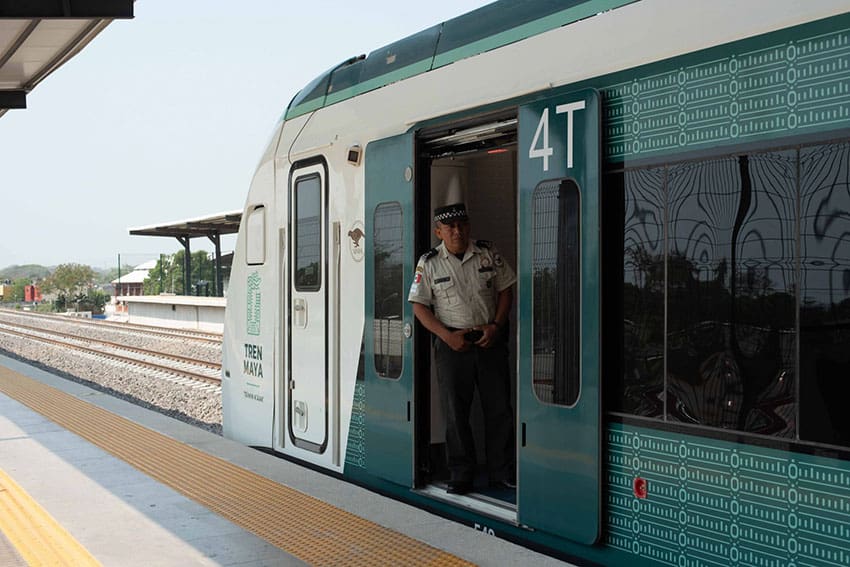
I recommend buying your tickets online in advance to avoid any issues. Keep in mind that on every stretch of the train — except the one from Valladolid to Mérida — the air conditioning started out great and got progressively worse as we went along. It was never completely off but there were plenty of times that I wished for more.
Cancún
The station in Cancún feels grand, like one of the classic European train stations you see in movies from the early 20th century. There was a good crowd the day I boarded, as the section from Cancún to Mérida is one of the most popular routes. On the train I met Lucy and Javier, two retirees who were traveling all over the Yucatán via the Maya Train, stopping in Valladolid, Mérida and Campeche.
“We remember when there was a train from Guadalajara to Mexico City,” Lucy told me. “We used to take it all the time.” The couple were looking forward to seeing what this new train was like.
That first ride to Valladolid was exciting. The train was gleaming — brand new, clean and super smooth. I bought a drink at the snack counter and chatted with the other riders. The view out the window this time of year was mostly dry jungle, but inside riders seemed happy to just chat and relax. There was no Wi-Fi on board, something I would come to discover was true of the entire route. Workers told me that some of the cars were outfitted with Wi-Fi, but even though on a few sections the network did appear on my phone, it was always without internet.
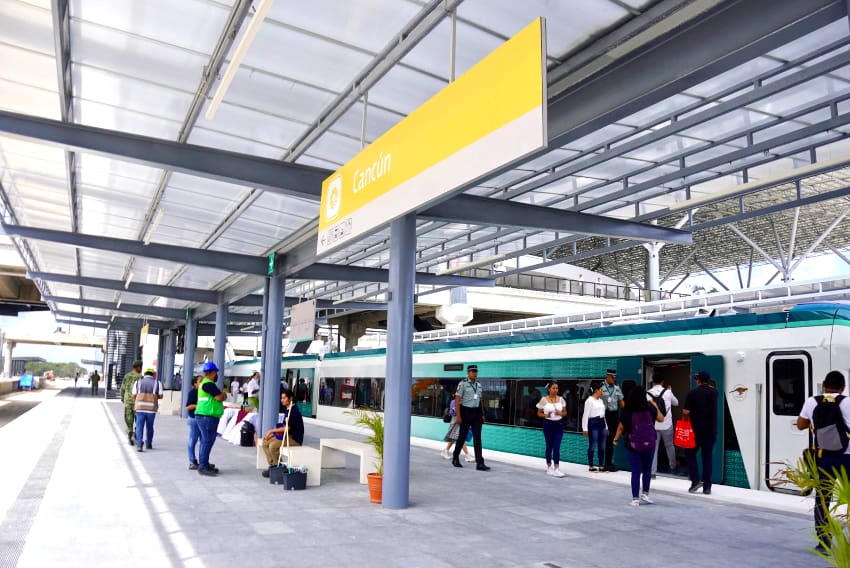
Getting to and from the train
Arriving at the Cancún airport, there are free shuttles that bring you to the train station from terminals 2, 3 and 4, departing five times a day.
Make sure to get one of these shuttles, because if not the taxi drivers will rip you off, charging at minimum 800 pesos, or US$50, for a 10-minute ride to the station.
Valladolid
The city of Valladolid is old-world chic, with a growing number of boutique shops and very decent regional restaurants. It’s a great base for exploring the amazing wildlife at the nearby Ría Lagartos biosphere reserve, particularly their flocks of electric pink flamingos, or visiting Las Coloradas, the area’s famous rose-colored salt flats. I stayed in one of the gorgeous nature villas at Oriundo Hotel outside of town, but most of the hotels and restaurants are right in the center of town. There are also many lovely cenotes nearby to while away a day swimming and picnicking.
Getting to and from the train
There are no taxis that wait at the station as of yet — though with increasing arrivals I think there will be — so arriving in Valladolid your option is the waiting bus that takes you to the ADO bus terminal in the center of town. The trip costs 35 pesos and lasts about 20 minutes. The fact that Valladolid is a small town and most of the action is downtown made this the most convenient connection of the whole trip. I stayed overnight in Valladolid and took the same bus back the next day and the ADO ticket counter people were fully informed about the bus’s schedule.
Mérida

With its crumbling mansions, sultry climate and exquisite restaurants and bars, Mérida is one of my favorite cities in Mexico. I stayed at The Diplomat, my favorite hotel, and took advantage of its proximity to the Santiago market to try some local fare. Mérida finally has a population willing and able to support its dozens of great eating and drinking options as well as some very fine art galleries and shopping.
Getting to and from the train
Arriving in Mérida in the evening there were no taxis but several e-trams — part of Mérida’s public transportation system — were waiting to take arrivals to both the La Plancha and Paseo 60 stations for 45 pesos. The trip took about 30 minutes. The bus driver knew little about the rest of the connecting route through the city, so I took a 70 peso taxi from the drop-off station to my hotel. Mérida has Uber and Didi, and both apps are inexpensive and work well — although wait times tend to be longer than in a big city like Mexico City. This makes getting around the city a breeze, and while I’m a big fan of public transportation I gave up trying to figure it out in Mérida and just took cabs or walked.
Getting back to the station was easy, but I had to go to the La Plancha tram stop the day before and ask about the train times which are not announced anywhere online that I could find. When I got there, the times were written on a tiny piece of paper taped to the ticket counter. When I asked the woman there if the times were published anywhere she said no; they “weren’t set yet.” Anyone wanting to know had to come to the station to check. I came back the next day and the bus to the train station did leave on time. It cost 45 pesos, like my trip into town.
Edzná
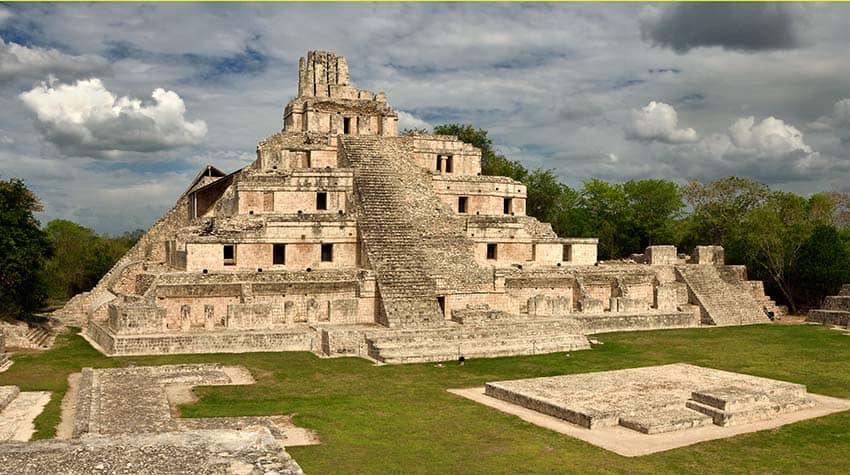
Leaving Mérida I decided to go all the way to Edzná to see if it would be possible to see the ruins there before they closed for the day. On the way I met Paulina who was traveling with two other women back from Mérida to Palenque where they lived. I asked her how the trip was going and she said their trip on the train was cheaper than the bus and took 4 hours less time so for them it was no-brainer. They seemed a happy group, even if by this time we were all sweating on this leg of the trip.
The archaeological ruins at Edzná, a former powerful regional capital on the Yucatán Peninsula from AD 400 to 1000, were stunning. The site is small, the buildings dramatic and there were only a handful of other tourists. I recommend going early in the day, as there is little tree cover and walking around in the midday heat almost did me in.
Getting to and from the train
When I got to the Edzná station things more or less fell apart, and I had to remind myself to go with the flow and embrace the chaos. I had previously asked about transportation in Edzná from other train workers and was told there would be taxis there, but when I arrived there was nothing but me, a hot breeze, some sad-looking palm trees and a stray dog. Zenaida, the woman working at the station, was extremely kind but a bit shocked by my assumption that there would be transportation.
Zenaida told me that a bus line is in the works but hasn’t been developed yet because “the station isn’t finished,” which was why there were no stores there either. I’m not sure how unfinished a station is when it’s already receiving passengers, but I kept my opinion to myself. Zenaida called a motorcycle taxi for me who might have been the only one in town and also offered car service from one of the station’s employees who uses his vehicle as a kind of Uber for tourists who want to get to the Edzná ruins there.
The ruins — the only attraction in Edzná as there is no town to speak of and only a single store along the highway — are 15 kilometers away and the hot wind in the back of the mototaxi made the trip feel like riding in a microwave. Abram, my driver, was a super nice guy and talked to me about the hotel that the government was building near the site that would allow people to spend the night there once it opens at the end of June — the same date Zenaida said that the Edzná station would be finished.
So down the road, it looks like there will be transportation and lodging; for now, be sure to bring water and food, as there are no shops at the ruins either. Since the train only arrives in Edzná in the afternoon and doesn’t leave until the next morning I took a combi — a small shared van — back to Campeche. The worker at the ruins said it came at 3:30 p.m. at a stop down the road. Instead, it showed up at 3 p.m., right at the entrance to the ruins. I almost missed it.
Campeche
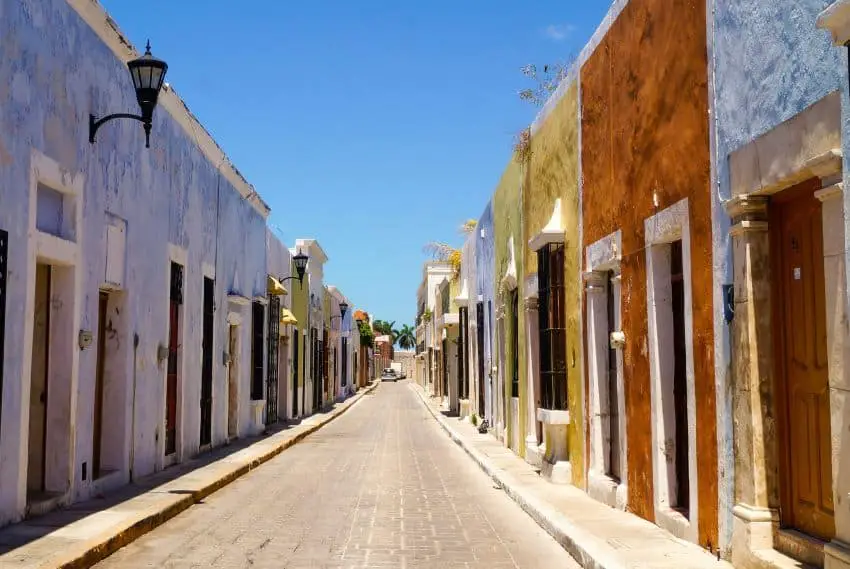
Campeche is another gem. Yucatán’s walled city was often attacked by pirates during the colonial years, and the city’s multi-colored facades and the remaining sections of its great wall make for a charming ambiance. The seafood here is also top-notch. Be sure to amble down Calle 59 with its cafes and bars lit up with twinkling lights in the evening. If you want to see Edzná, I recommend staying in Campeche and making it a day trip.
Getting to and from the train
Since I didn’t arrive in Campeche on the train, I didn’t get the experience of coming into town from the station. I now know that buses wait for each arriving train to take passengers into the city center. They drop you off on the oceanfront, where the massive letters that spell out Campeche stand., From there, it’s a short walk to the restaurants and hotels of the Historic Center.
Getting back to the station was painful. There’s no information online except for a few articles from December 2023 that say there are stops at four different points throughout the city. I ended up going to the bus station and being told there was a bus that picked up riders at 6:30, 10:30, and 11:30 at the same spot as the drop-off. I arrived there at 11:10 and waited until 11:34, but no bus came.
“Sometimes they come early and sometimes they come late!” a man wearing a Maya Train hat told me. “That’s how we do things in Campeche, everything backwards!” said his buddy. My advice for Campeche is to take a cab to the train station, which will cost you 150-200 pesos from the Historic Center.
Palenque
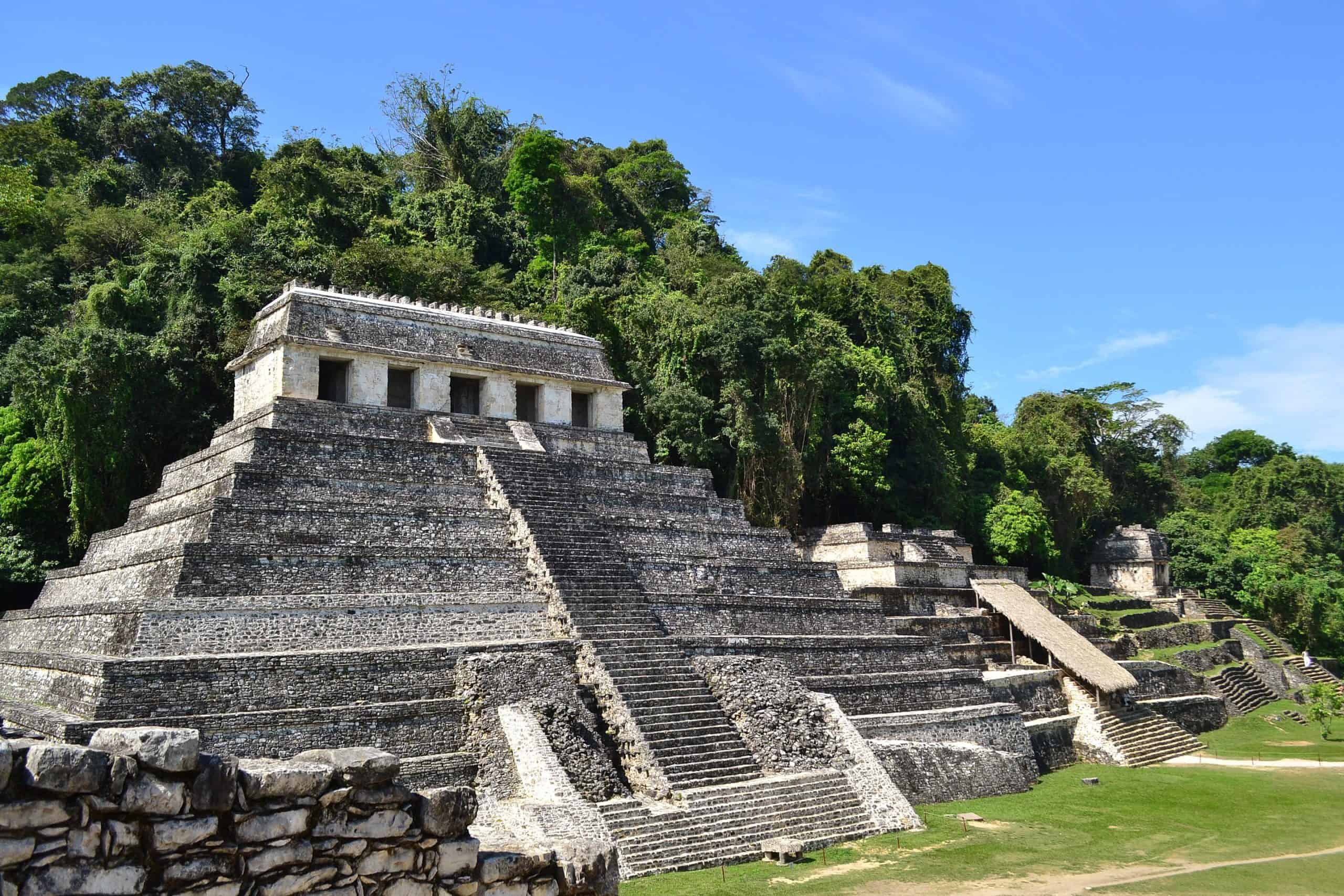
The home of one of Mexico’s greatest archaeological sites is also known for its waterfalls and swimming holes, so that’s what I chose to do on this part of the trip — I’d already seen the ruins before. The waterfalls of Misol Ha, Roberto Barrios and Agua Azul are all gorgeous places to spend an afternoon staving off the heat and communing with nature, especially during the week, when there are fewer tourists. The town of Palenque itself has never held much draw for me, but it’s a good base for exploring the region.
On the train, the landscape from Campeche to Palenque was a little more exciting, passing small farms, cattle ranches and greener jungle. The Palenque station was probably the most grandiose and lovely of all the stations along the route, and many passengers I met along the way were making the trip from Campeche or Mérida straight to Palenque, so I envision this station getting a lot of use in the future.
Getting to and from the train
The day before going to Palenque, I stopped off in Escárcega, where, once again, there was no public transportation. The station workers called me a cab. Coming back the next day they told me the train was having technical difficulties and it would be at least an hour and half late. We finally got into Palenque 2.5 hours late, and despite the station manager assuring us that there was a public bus that would take us to the ADO bus station in the center of town, it never arrived.
Instead, there were taxis, which charged 150 pesos to the hotel zone in town and 200 to the hotels on the road to the ruins. From the ADO station in town, I found out that the buses to the Maya Train station leave at 6 a.m. every day and wait for the arrivals on the 5 p.m. train every afternoon. When I mentioned to him that when we arrived late there was no bus waiting, he said, yeah, sometimes if they tell us train is late we don’t wait.
Reflections on my journey
Except for Edzná, all of these cities are major stops on the train, and so are the most likely to have transportation. Still, as you can see, it wasn’t well organized at many of the stops. Some of the small stations along the route are not fully operational yet, and many lack basic infrastructure. It’s more likely that these smaller stops will be useful for locals traveling around the peninsula than tourists like the two women riding from Campeche I met going to see their mother in the tiny town of Carrillo Puerto.
I do think some of the operational kinks are bound to be fixed as the train heads towards its first anniversary, but for international tourists who don’t speak Spanish, much is needed to make travel smoother including informational signs, a map of the route at stations, reliable and easy-to understand-public transportation and English-speaking staff. While it was an adventure and I did love riding on a train again, I think I will hold off on another trip on the Maya Train until it’s a little further down the track.
Lydia Carey is a freelance writer and translator based out of Mexico City. She has been published widely both online and in print, writing about Mexico for over a decade. She lives a double life as a local tour guide and is the author of Mexico City Streets: La Roma. Follow her urban adventures on Instagram and see more of her work at www.mexicocitystreets.com.
